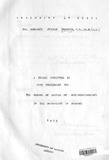| dc.description.abstract | Snakebite is an occupational hazard and those at greatest risk are those who work in the fields. Young 'adventurous children from another group at high risk. The majority of snakebites occur during the productive years of life for both sexes. The great r numbers of Snakebite victim in Kenya take hours to days before they present in hospital and this increases the morbidity and mortality of those affected. In many parts of the country today snakebite is still associated with witchcraft and forgoes beyond nature. The overall incidence of snakebite in the country is difficult to estimate but as a cause of morbidity and mortality is an insignificant medical problem. All snake groups of medical important are encounter-red in Kenya. The vipers are by far the most important group of snake s in the country. The puff adder (Bitis arietans) is responsible for most of the of snakebite and deaths in the country. The clinical picture produced by viper invocation include initial pain at site of bite followed by local tissue swelling which in severe poisoning may progress to impair circulation and cause danger in the affected limb. Tissues at site of invocation become neurotic and slough off. Some cases of viper bite present with hemorrhagic man it stations due to disseminated intravascular clotting and inhibition of coagulation by anticoagulant activity of the venom. Deaths duo to viper bites are not usual and are often delayed for 4 - 24 hours depending on the amount of envomation. The vipers strike low and most of their bit s can be prevented by the wearing of boots or shoes. First id in the form of a tourniquet is of no value in viper bites. Two other vipers are worth of note. The gaboon viper (Bitis gabonica) is the deadliest of the vipers. .It is strictly a forest animal and is confined to the Kaimosi forest only. The carpet viper (Echis carinata) is confined to the arid
regions of Northern Kenya. Its venom has v ray strong coagulating powers. Other vipers in the country are of little medical importance. The elapides are represented in this country by the
Cobras, mambas and garter snakes. The mambas are the Most deadly of the elapides but cobras are more numerous and responsible for more bites. The spitting cobra (Najanigricolis) is the second snake of importance in the country and with the puff adder are responsible for nearly all the snakebite invocations in the country. The elapide venom has mainly neurotoxin effects and any of the following Symptoms may occur - nausea, vomiting, salivation. Sweating, autopsies, abolition of every movements and accommodation, slurring of speech, drowsiness and a gradually nor easing difficulty in breathing. Death in elapine poisoning is due to respiratory failure and coura within minutes to an average of 4 to 8 hours. A tourniquet may be life saving in elapine poisoning and should be applied as a first aid measure while awaiting antivenom to be given.The poisonous columbines - boomslang and vine tree snake, have a limited distribution in the country and are of no medical important in this country. Symptoms due to boomslang poisoning take hours to develop and present in the form of bleeding, allover the body. There is no antivenom against boom slang poisoning in the country. Sea snake bites re unknown in the country but with increasing deep sea fishing, cases may be amount rod in future. The use of a tourniquet by the general public is not advised because most of the long delays before arrival in hospital and also because most snakebites are caused by the vipers. Those at high risk should be educated on the importance of try unsporting victims to the nearest hospital as quickly as possible. The use of anti-venom is not indicted in all cases of snake bit. Those with minimal or no signs of poisoning should b treated conservatively.
Snakebites in Kenya are not an appreciable medical problem in terms of numbers of victims affected and with more caution on prevention and management of victims the morbidity and mortality can be reduced to minimum. | en_US |
| dc.description.department | a
Department of Psychiatry, University of Nairobi, ; bDepartment of Mental Health, School of Medicine,
Moi University, Eldoret, Kenya | |

